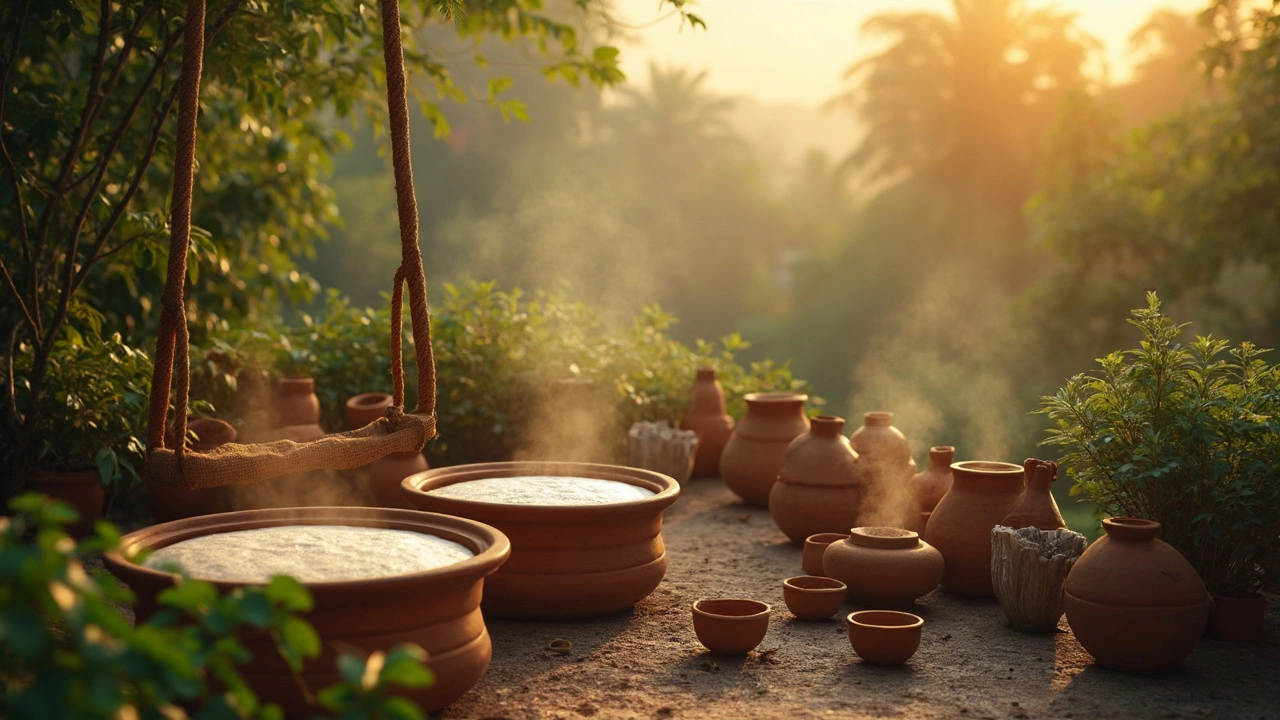Simple Secrets to Quick Dosa Batter Fermentation Without Yeast
 Feb, 15 2025
Feb, 15 2025
There's nothing quite like a perfectly crispy dosa paired with your favorite chutney or sambar. If you're like many wanting to whip up a batch without waiting forever for the batter to ferment, you're in for a treat. The secret to a quick fermentation without yeast isn't magic—it's all about the right techniques and a little know-how.
First things first, understanding what makes fermentation tick is key. Fermentation in dosa batter doesn’t rely on yeast but on naturally occurring microorganisms in the ingredients. Rice and urad dal, your main players, are packed with the right kind of bacteria to start the fermentation process. Give these natural helpers a cozy environment, and they get to work fast, way faster than you’d think.
Temperature is another biggie. A warm setting does wonders. If you’ve ever been told to wrap the batter bowl in a blanket or place it in the oven with just the light on, it's for good reason. Cold places slow things down, often frustrating many. Keeping things toasty speeds up things without compromising taste.
- Understanding Fermentation
- Role of Temperature and Environment
- Ingredient Secrets for Quick Fermentation
- Storage Techniques for Better Results
- Common Mistakes and How to Avoid Them
Understanding Fermentation
So what's the deal with fermentation when making dosa batter? Unlike some baking recipes that rely heavily on yeast, dosa batter depends on naturally occurring microorganisms. When you combine rice and urad dal, you're setting up a perfect stage for these beneficial bacteria to do their thing.
The Microbial Players
While it sounds scientific, it really boils down to bacteria found naturally in rice and dal. Particularly, lactobacillus bacteria are the stars here. They break down starches in the rice and dal, releasing CO2, which lends that fluffy airiness to dosas. No need for added yeast; your ingredients bring their own fermentation team.Essential Conditions for Fermentation
The magic happens best when the environment supports these microbes. Think of it like setting up a playdate they can't resist attending. Optimal temperature ranges from 25°C to 32°C (about 77°F to 89.6°F) to keep them active. Extremely cold environments can put them to sleep, slowing down the quick dosa turnaround we crave.Timing Matters Too!
Planning to get your dosa batter ready in time for breakfast means understanding the fermentation timeline. Typically, eight to twelve hours can yield good results, but if in a hurry, you can sometimes get away with a mere six hours if conditions are just right. It's a dance of patience, but experimenting with time and temperature can speed up the process without yeast.Next time you're mixing up a batch of this delightful South Indian staple, remember it's all about creating the ultimate conditions for bacteria to flourish naturally. With patience and a little know-how, those dosas will be ready to roll in no time!
Role of Temperature and Environment
When it comes to making top-notch dosa batter, a cozy environment can make all the difference. The right temperature turns your kitchen into a fermentation haven, accelerating the process even without yeast.
Temperature plays a lead role. Ideally, the batter should ferment at around 86°F (30°C). This is warm enough to encourage friendly bacteria to thrive and do their job fast. Now, unless you're in a naturally warm climate, hitting this sweet spot might need a bit of help.
Creating a Warm Spot
If your kitchen tends to be chilly, here are a few tricks to warm things up:
- Oven Light Trick: Simply place the bowl inside your oven with just the light on. This little setup can raise the temperature inside just enough for proper fermentation.
- Cozy Blanket Wrap: Wrap the bowl with a warm towel or blanket. This insulates the bowl, trapping the heat and giving those natural microbes a comfy zone to work their magic.
- Near a Heat Source: If you have a radiator or a warm spot in your home, placing the batter nearby can provide the necessary warmth.
Avoiding the Chill
While warmth is your friend, cold is the enemy. If the batter sits in a chilly spot, the microbes slow down or even stop working, leaving your batter flat and lifeless. Avoid storing the batter in places like refrigerators or near drafty windows during the fermentation period.
Fun Fact
Did you know a study showed that outdoor humidity could also play a role? Yep, higher humidity can aid in faster fermentation. So, if you live somewhere a bit humid, consider yourself lucky!

Ingredient Secrets for Quick Fermentation
When it comes to dosa batter, sometimes the magic lies in the details. Choosing the right ingredients can make all the difference in speeding up that all-important fermentation process without using yeast. Here’s how you can tap into those fermentation secrets straight from your pantry.
Go Fresh with Ingredients
Always start with fresh rice and urad dal. Old stock tends to lose its natural ability to ferment quickly. Freshly split urad dal and new rice offer the right kind of sugars and starches that bacteria love.
Add Fenugreek Seeds
Fenugreek seeds are one of the best-kept secrets in achieving that quick ferment. Just a tablespoon or so per cup of dal can up the microbial activity significantly. This not only helps with fermentation but also adds a subtle flavor.
Opt for Poha
Adding a handful of flattened rice, or poha, into your rice while soaking can act as an accelerator. Poha is great at absorbing moisture, creating a slight acidity that encourages faster growth of natural bacteria.
Baking Soda Boost
Though a bit controversial, if you're really in a rush, a tiny pinch of baking soda can be your friend. Stir it in just before you set the batter aside. This won't replace proper fermentation but can give it that extra boost.
| Ingredient | Effect on Fermentation | Recommended Amount |
|---|---|---|
| Rice | Makes base starch for fermentation | 2 cups |
| Urad Dal | Main protein source for bacteria | 1 cup |
| Fenugreek Seeds | Enhances microbial activity | 1 tsp |
| Poha | Boosts moisture absorption | 1/4 cup |
With these ingredient hacks, your quick dosa batter can go from average to outstanding in no time. Give them a try and see how these small changes can help speed up fermentation naturally.
Storage Techniques for Better Results
Once you've got your dosa batter mixed up, the way you store it can make or break its fermentation game. Let's dive into some trusty methods to keep that batter thriving.
Use the Right Container
Choosing the right container is crucial. Opt for a large enough container to allow room for the batter to rise as it ferments. Look for something non-reactive like stainless steel or glass. These materials help maintain a consistent environment and prevent unwanted chemical reactions with the fermentation process.
Seal It Right
Cover the container loosely with a lid or even a clean cloth. A little air circulation is good to let those natural microbes do their thing. But, you don't want it too exposed either, as this could dry out the top layer.
Ideal Placement
If you live in a colder place, there's a simple trick—store your batter inside an oven with the light on or place it in a warm corner of your kitchen. You’re aiming for a consistent, mild warmth, nothing scorching hot.
Fridge Storage for Later Use
Sometimes you want that quick dosa, but aren’t planning to cook right away. If you've achieved the perfect fermentation but want to store for extended use: pop it in the fridge. This slows down the process but keeps the batter fresh. Just be sure to bring it back to room temperature before cooking.
Watch Out for Over-Fermentation
A quick check on the batter's smell and taste can tip you off about over-fermentation. A pleasantly sour scent is normal, but if it's too strong, you might have left it too long. Adjust your environment or timing next batch.
Following these storage tips ensures your batter is always ready to create those delightful, crispy dosas—or as I call them, crispy circles of joy!

Common Mistakes and How to Avoid Them
Getting the perfect dosa batter without yeast might take a little practice. However, avoiding common slip-ups can make the process so much easier.
Avoiding Temperature Troubles
Temperature is vital for fermentation. Folks often stick the batter in the fridge too early, halting fermentation completely. Instead, let it ferment in a warm place before storing in the fridge. Remember, warmer spaces (not too hot!) kick-start the process.
Water Woes
Using too much or too little water can throw off your batter consistency. A thick batter won't ferment well, while a runny one could get too sour. Aim for a medium consistency that drips but isn't watery.
Ingredient Imbalance
Getting the right rice-to-dal ratio is crucial. A common mistake is skimping on urad dal which is a powerhouse for fermentation. Ensure a ratio of about 3:1 rice to dal for optimal results.
Skipping the Soak
Many underestimate the soaking step. Skipping it or not soaking long enough can mean not enough fermentation magic in your ingredients. Give them a good 4 to 6 hours to soak in water before grinding.
Grinding Errors
Overheating urad dal while grinding can kill the natural microorganisms needed for fermentation. Use cold water while grinding to keep the temperature down. Consistent grinding makes a fluffier batter, which is what you want.
| Mistake | Solution |
|---|---|
| Cold environment | Keep batter in a warm spot |
| Incorrect consistency | Aim for medium thickness |
| Poor ingredient ratio | Use 3:1 rice to dal |